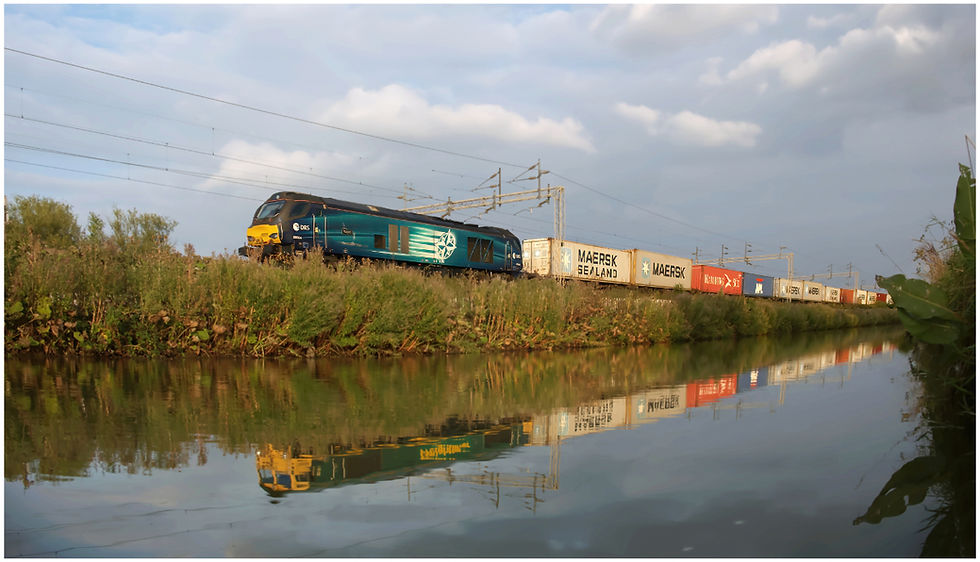Probably The Best Locos In The World.
- eddieholden3
- Sep 21, 2024
- 4 min read
The Carlsberg reference is really a Danish reference and refers to my recent visit to Denmark in search of the classic NOHABs those being the MX,MY and MZ locos.
I set off by train to Heathrow on the 0725 departure from Teignmouth but it wasnt until Westbury that the trolley reached me and i was able to get a coffee, chuffin rubbish service.
Having booked in and passed through security with my overloaded camera bag i settled down for a slap up brunch, delicious.
I decided to Fly into Billund on this occasion. To fly into Copenhagen would have been cheaper but it would have meant flying with Ryan Air. In my view they are a shocking airline who squeeze you for every penny they can. It is seldom cheeper by the time you have been stung for all the extras. Their greed and poor service has lost them my custom.
On arrival at Billund i was met by my good friend Kasper Pederson and we headed straight for Fredericia to rendezvous with a southbound
freight from Aarhus hauled by an MX NOHAB loco number 1029 and an ex Luxembourg Class 1800 number 1831. After checking in to my hotel i headed for a night shoot at Federicia where i saw my first Class MZ.
What an amazing loco, there were two stabled and i set about getting some low light shots. The MZ is a 38

50 hp loco with a V20 EMD two stroke engine. Only 6 remain of the Mk 4 version in use in Denmark. They were built by the NOHAB company of Sweden and the Mk 4 MZs were built in 1977 and 78. The last 6 Mk 4s in Denmark are operated by DB Scandinavia.

The next day we headed to Velge where we photographed a Viking Rail operated freight powered by a Class MX and a Class 1800 heading to Aarhus followed by a freight heading to Rønland which we managed to photograph at Vejle a few times before racing ahead of it to Herning. This freight was powered by an MZ locomotive which was piloted from Vejle onwards by an ex Sedish Class Z70 shunter. The purpose behind this is that the MZ is not fitted with ECTS signalling equipment but the shunter is, the problem then exists that the whole train cant travel faster than 20mph giving us plenty of opportunity to get ahead of it.

In the afternoon the heavens opened so we headed back to Fredericia to bag some shots in the r
ain from the cover of the station roof.
Day three and the plan was to rendezvous with the returning freight from the Rønland chemical plant which we did at Skjern. The return empty working had the added bonus of giving a recently refurbished class MX a lift back to Fredericia. She had the honour of piloting the whole ensemble because she had recently been fitted with ECTS signalling equipment thus

making the shunter redundant. The train stopped at Herning to pick up some wagons making the train even bigger.
Following this we headed south to Germany to spend a few days photographing the trains that operated on the Niebüll to Sylt line. Sylt is one of the north Frisian Islands near the border with Denmark. The island is joined to the mainland by a 5 mile causeway dividing the Wadden Sea. Semaphores still control the line on the mainland and are due for replacement within the next two years. Car transporters run frequently operating a shuttle service, the magical thing is that the drivers of the cars remain with their vehicles and get to ride on open wagons. How cool !.

There are also local regional trains and Inter City trains. The shuttles are mainly in the hands of the unique Class 245s but are frequently
replaced by the diesel hydraulic class 218 locomotives always in pairs. These fantastic locos date back to the 70s, 60 of the original 410 still remain but are being withdrawn rapidly. The 218s also work the trains to Hamburg and the 245s work the local Niebüll to Westerland trains. Occasionally a Class 1700 will make an appearance. The rival car transportation shuttle service is operated by Vectron DE locomotives. There is plenty to see with semaphore signals controling stations and passing loops. A word of advice...watch out for gangs of marauding mosquitoes at sunset. They are vicious and do not take prisoners.

After our two day trip to Germany we crossed the border back to Denmark, interestingly there was no border control not even a sign to say you are passing from one country to another.

The following day a special event was booked to take place. A repeat of last years successful photo shoot using one of Lokaltögs MX locos and running on one of their lines in conjunction with the normal daily timetable. The event was organised by the NOHAB group of Germany mainly using my friend Kaspers knowledge and contacts. This year they used Lokaltogs line from Kølg to Rødvig and Faxe Ladeplads and the MX loco 1005 built in 1964.



